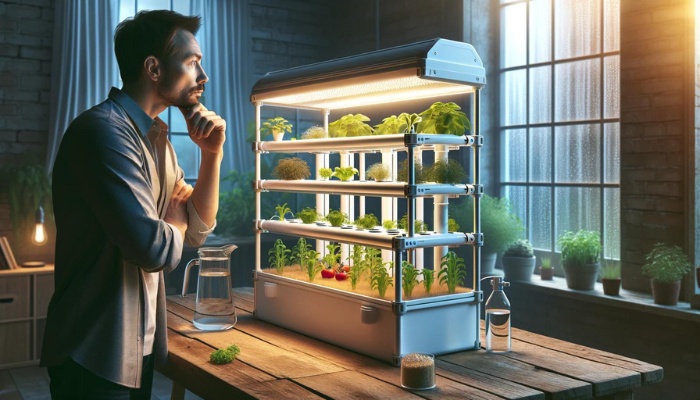Just when you thought you’d perfected your hydroponic setup, you realize the water temperature might not be in the ideal range. You’re not alone in facing this challenge.
Maintaining the right temperature is essential for optimal plant growth, and straying too far from the sweet spot can lead to a host of problems, from stunted growth to disease.
Understanding Ideal Temperature Ranges
Maintaining water temperatures between 65°F and 80°F is essential for optimal growth in hydroponic systems. This range effectively supports most plant species’ metabolic and physiological processes.
However, not all plants thrive equally within this spectrum. Each plant species has its unique optimal temperature point, which aligns with its natural habitat conditions.
Therefore, when selecting plants for your hydroponic system, you must consider their specific temperature preferences to ensure vigorous growth.
Seasonal variations significantly impact your ability to maintain these ideal water temperatures.
During warmer months, water temperatures can easily exceed the upper limit of this range, especially in systems that aren’t equipped with cooling solutions.
Conversely, in cooler seasons, maintaining temperatures above the lower threshold can become a challenge, necessitating heating measures.
To navigate these fluctuations, you’ll need to employ strategies such as water chillers in the summer and heaters in the winter or possibly insulate your system to mitigate the effects of ambient temperature changes.
Understanding and adjusting for these factors ensures that your hydroponic system provides the most conducive environment for your plants, irrespective of seasonal variations or specific species requirements.
Effects of Incorrect Temperatures
Incorrect temperatures can have adverse effects on your hydroponic system’s plant health and productivity. Deviating from the optimal temperature range can induce plant stress, significantly hindering growth and yield.
When temperatures soar above the recommended levels, plants tend to exhibit signs of heat stress.
This condition can lead to a rapid decrease in oxygen solubility in water, causing root oxygen deprivation and, consequently, reduced nutrient uptake efficiency.
On the flip side, excessively low temperatures can slow down metabolic processes in plants, leading to stunted growth.
This chilling effect complicates nutrient absorption as the fluidity of cellular membranes is compromised, reducing nutrient uptake and transport throughout the plant.
Furthermore, such unfavorable conditions can predispose plants to root diseases as pathogens thrive in stressed environments, further complicating nutrient assimilation.
Monitoring and Adjusting Water Temperature
Monitoring and adjusting your hydroponic system’s water temperature is essential for ensuring optimal plant growth and health.
You must consider seasonal variations and the specific needs of different plant species.
Seasonal changes can dramatically affect the water temperature in your system, leading to fluctuations that might not be ideal for your plants.
To maintain the right temperature, you’ll need to analyze the unique requirements of the plant species you’re cultivating.
Each species has its own optimal temperature range for growth and nutrient uptake. Ignoring these specifics can hinder plant development, affecting both yield and quality.
As seasons change, you might find the need to either cool down or warm up the water to keep it within the desired range.
This process involves careful monitoring and timely adjustments to ensure your plants remain in an environment where they can thrive.
Tools for Temperature Management
Several tools are essential for effectively managing the water temperature in your hydroponic system, ensuring optimal conditions for plant growth.
With the right equipment, you can maintain the ideal temperature range, taking into account seasonal considerations that significantly impact water temperature.
Here’s a concise list of tools that are indispensable for temperature management:
- Digital Thermometers: These provide precise, real-time water temperature readings, enabling you to monitor fluctuations accurately.
- Heating Mats: Placed beneath reservoirs, they gently warm the water and are ideal for cooler months or environments. Their use must be carefully balanced with seasonal considerations to avoid overheating.
- Water Chillers: For hot climates or seasons, water chillers are critical. They actively cool the water, maintaining temperatures conducive to plant health.
- Temperature Alarms: These devices alert you when water temperatures deviate from the desired range, allowing for immediate corrective action. They’re particularly useful in avoiding the adverse effects of sudden temperature spikes or drops.
Best Practices for Consistency
Achieving and maintaining the optimal range necessitates a blend of vigilance and strategic planning, especially in environments subject to fluctuating external temperatures.
Integrating temperature alarms into your system can serve as an invaluable safeguard. These devices alert you when temperatures deviate from the desired range, enabling prompt adjustments.
It’s not just about reacting to changes; it’s about preempting potential fluctuations before they compromise your plants’ health.
As external temperatures vary, adjusting your hydroponic setup becomes essential.
In warmer months, consider employing cooling mechanisms or shading to mitigate heat absorption. Conversely, during cooler periods, insulation or heating solutions can help maintain warmth.
It’s about anticipating the impact of seasonal changes and adjusting your management practices accordingly.

